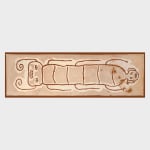Pachacamac Culture
26'7" x 83'8" in.
Further images
The ancient Andean artists were masters of comedy—perhaps even divine comedy—as epitomized in the painted textiles of the Huari/Chancay culture. This artistic practice, rooted in humor, is characterized by a delightful and childlike style, free from the constraints of perspective. Anthropomorphic figures, such as the iconic upraised-armed figures or Janus-headed centipedes, often found in these textiles, can trace their origins to the "Ocucaje object" of the Ocucaje culture around 100 BC.
The execution method of these works—painted pigment on cotton—allowed for a freestyle and celebratory mode of representation unique to these cultures. Decorative elements surrounding the figures may reference the diverse patterns seen in woven textiles from the pre-Columbian period, enriching the visual narrative.
Similar artistic examples can be found in the study collection of Anni Albers, a pivotal figure in the development of the Bauhaus, American modernism, and fiber arts in the 20th century. Albers’ fascination with pre-Columbian textiles was fueled by her travels to Mexico and Peru during her tenure at Black Mountain College. Her efforts contributed to the formation of significant pre-Columbian collections in the United States, including the Harriet Engelhardt Collection in the 1950s and the Josef and Anni Albers Collection.
Exhibitions
Frieze Masters, London 2022Confluences: 4000 Years of South American Art, Cork Street no.9, London. 2022

















